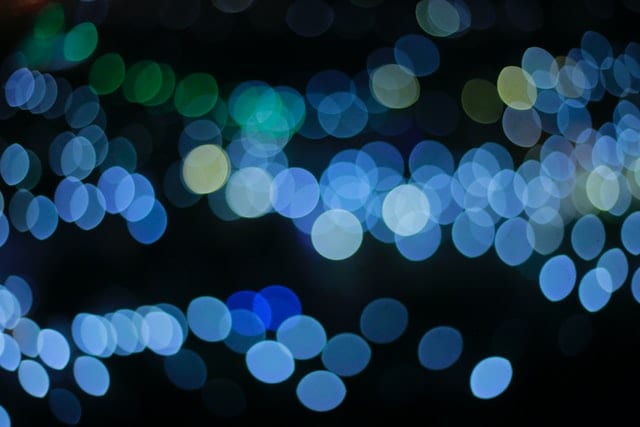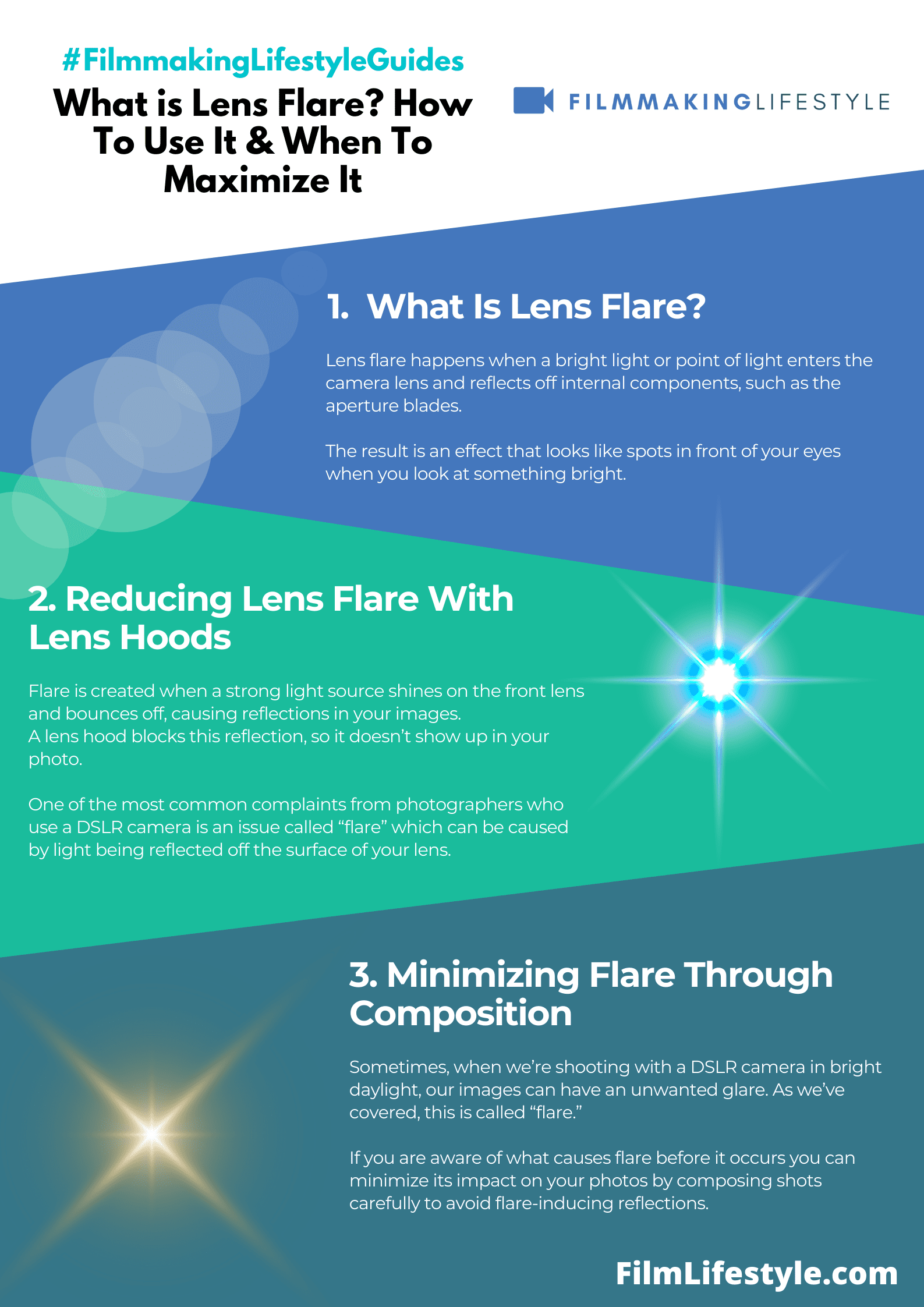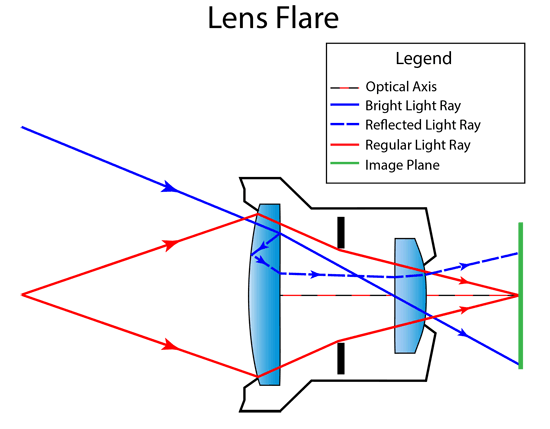Lens flare is a problem with which image makers have long battled.
Have you ever been in a movie theater and looked up at the screen to notice that your eyes are not adjusting to the change in light?
In amateur videos, it can be a mistake. But it can also be used as a creative choice, and we’ll show you how.
What Is Lens Flare?
This is called lens flare, and it’s a common occurrence. We’ll explore what lens flare is for those who may be unfamiliar with it.
Lens flare is a type of lens artifact that occurs when light reflects off the surfaces inside the camera and projects out into your images.
It can be used as an artistic effect, but it’s often seen as a problem to remove from photos and videos. Lens flare is sometimes mistakenly called “ghosting.”
LENS FLARE
What Is Lens Flare?
Lens flare happens when a bright light or point of light enters the camera lens and reflects off internal components, such as the aperture blades.
The result is an effect that looks like spots in front of your eyes when you look at something bright.
Lens flares can happen to any photographer, whether they’re using a DSLR camera with interchangeable lenses or their phone’s built-in camera.

Have you ever noticed those streaks of light that sometimes appear in photographs?
That’s lens flare, a common phenomenon in photography that can add a magical touch or be an unwanted distraction.
We’ll jump into what causes lens flare and how it can both enhance and detract from your images.
Understanding lens flare is essential for photographers aiming to control this effect.
Whether it’s the halo around a sunset or the glare in a backlit portrait, we’re here to unravel the mystery behind these light artifacts.
Stick with us as we explore how to harness lens flare to our creative advantage.
What Is Lens Flare
Lens flare occurs when light scatters in lens systems through reflection and refraction.
It’s most commonly visible when a bright light source, like the sun, hits the lens at an oblique angle.
This phenomenon creates visible artifacts in the final image or film.
In cinema, it’s often associated with the iconic visual style of directors like J.J. Abrams, especially prevalent in films such as Star Trek and Super 8.

Lens flares manifest in various shapes, such as:
- Streaks and lines,
- Hazy glow,
- Rings or halos,
- Starbursts.
The character of the flare depends on several factors.
These include the lens design, the shape of the lens diaphragm, the quality of the lens coatings, and the angle of the light.
Understanding the optics behind lens flare allows us to predict and control its occurrence.
With careful manipulation, we can avoid unwanted interference or introduce lens flare deliberately to enhance the storytelling.
In filmmaking, we use lens flare to evoke specific emotions or emphasize moments.
The aesthetic contribution of lens flare can be a powerful tool, instilling wonder, drama, or even a sense of futurism into our scenes.
Technological advancements in lens manufacturing and coatings aim to minimize lens flare.
But, the demand for its artistic effect ensures that it remains a cherished visual element in our creative arsenal.
Causes Of Lens Flare
When we’re crafting a scene, understanding the causes of lens flare is vital.
It often results from the angle at which light enters the lens and interacts with the glass elements inside.
Direct light sources outside the frame can sneak into our lens‚ creating that distinct glare or haze.
We’re particularly mindful of this when filming at sunrise or sunset.
Sometimes internal reflections within the lens cause flare.
Those reflections confuse the sensor or film‚ scattering light in the process.
Here’s how various elements contribute to lens flare:
- Internal lens coatings: reduce some reflections but can’t eliminate them entirely,
- The number of elements in a lens: more elements may increase the chance of flare,
- The quality of the lens: higher quality lenses have better anti-flare properties.
Dirty or scratched lens surfaces also contribute significantly to lens flare.
Even fingerprints can cause unexpected light diffusion.
In scenes with high contrast, lens flare becomes more pronounced.
Blacks may not be as deep‚ and highlights may blow out, detracting from the desired cinematic look.
Manipulating camera placement and maneuvering light sources is a part of our creative process.
Moving the camera just a fraction can sometimes alleviate undesirable flare.
With advanced lenses and coatings, we aim to minimize unwanted flares.
Yet we can’t forget that each flare pattern is unique to the lens that creates it.
Films like J.J. Abrams’ Star Trek series have turned lens flare into a signature element.
They demonstrate its power to craft a specific atmosphere or highlight an emotion.
We keep researching and experimenting to ensure lens flare is our artistic choice, not a random occurrence.
It’s another tool in our visual storytelling arsenal.
Types Of Lens Flare
We understand that lens flare isn’t just a singular phenomenon.
Different types of flare can manifest, each altering the visual narrative of a scene in its unique way.
To better harness these effects, we categorize lens flare into several distinctive types:
- Veiling Flare – This type reduces contrast across the image and creates a hazy appearance. It commonly occurs when a bright light source like the sun is just outside of the frame.
- Ghosting Flare – Manifesting as small, colorful artifacts in the shape of the aperture, ghosting can add an unexpected whimsy or become a distracting element.
In narrative filmmaking, we see a purpose for each kind of lens flare. The spaceship entry in the iconic opening of Star Wars exemplifies how ghosting flares can elevate a moment, creating a palpable sense of awe and scale.
Meanwhile, veiling flares might be employed to evoke a dream-like or flashback sequence, wrapping the scene in a soft, gauzy light.
We also encounter starburst flares.
These flares present with rays emanating from light sources and become more pronounced with narrower apertures.
The rays contribute to a scene’s perceived sharpness and texture.
Saving Private Ryan utilizes this effect to play with the viewers’ perception of reality versus memory.
Another type we observe is ring flare, often seen as a halo or circular reflection.
The distinct circle adds an ethereal quality, potentially suggesting an otherworldly presence or simply enhancing the visual style of the film.
The unique attributes of each lens flare type are pivotal for expressive visual storytelling.
Leveraging them allows filmmakers to guide audience emotions subtly but powerfully.
Through controlled experimentation, we continue to explore the boundaries of how lens flare can embellish and transform cinematic expression.
Effects Of Lens Flare On Photos
Lens flare adds a layer of complexity to visual storytelling.
It’s not merely an artifact but a narrative tool that captures the raw interplay between light and lens.
The presence of lens flare often signifies a moment of revelation or intensity.
Movies like Super 8 use it to suggest there’s more to the scene than meets the eye.
It creates a sense of raw authenticity, especially in documentary filmmaking.
Audiences feel connected to the realism that flare brings to the cinematic moment.
In some cases, lens flare helps to convey the time of day.
The golden hour, when the sun is low, naturally produces warm flares that evoke certain emotions and atmospheres.
Instances of lens flare could also represent a character’s inner turmoil or clarity.
In Star Trek, lens flare accentuates the high-tech, otherworldly ambiance of the scenes.
Here are a few ways that lens flare alters the audience’s experience:
- It provides an aesthetic that feels genuine to the setting.
- It amplifies the emotional weight of a moment.
- It signifies key plot points to create engagement and intrigue.
Lens flare can also function as a visual transition.

It offers a unique method to shift from one scene to another seamlessly.
Although lens flare might seem intrusive to the untrained eye, in filmmaking it’s all about intentionality.
It holds the power to illuminate or obscure, guiding viewer focus deliberately.
Skillful application of lens flare caters to the desired mood of a scene.
Whether it’s depicting a character’s isolation or their enlightenment, flare serves a significant role.
Merging flare with composition, color grading, and camera movement results in an evocative sequence.
That’s why filmmakers are increasingly utilizing flare to refine their storytelling craft.
Controlling And Harnessing Lens Flare
Controlling lens flare often involves precise camera angles and lighting setups.
Our goal is to manage the intensity and position of light sources to achieve the right effect.
High-quality lens hoods can minimize unwanted flare.
Using matte boxes also allows us to control the light entering the lens.
Positioning the camera so the light hits the lens indirectly is a technique we use to induce lens flare deliberately.
We sometimes use objects within the scene to block or filter the light partially.
Post-production software has given us powerful tools to add or enhance lens flare.
Editors can manipulate intensity and color to fit the mood of the scene.
Certain films, like J.J. Abrams’ Star Trek, have popularized the intentional use of lens flare.
Such creative choices have become a stylistic hallmark, influencing many filmmakers.
Experimentation is key to mastering lens flare – here are some techniques we explore:
- Adjusting the aperture to control the shape and size of the flare,
- Moving the camera during shooting to change the flare’s trajectory,
- Using different lenses and filters to see varying flare characteristics.
We understand that each project may require a unique approach to lens flare.

It’s about finding the balance that works for the story we’re telling.

What Is Lens Flare – Wrap Up
We’ve explored the captivating world of lens flare and its power to add depth to visual narratives.
It’s clear that with the right techniques and tools, we can harness this phenomenon to create stunning imagery.
Whether we’re aiming for a subtle glow or a dramatic streak of light, the creative possibilities are endless.
Remember, it’s all about striking that perfect balance to tell our story in the most compelling way.
So let’s grab our cameras and let the light guide our next masterpiece.
Frequently Asked Questions
What Is Lens Flare?
Lens flare occurs when light scatters in lens systems, often due to bright light sources, producing a characteristic visual effect in photos.
Can Lens Flare Be Controlled During Photography?
Yes, lens flare can be controlled by using precise camera angles, lighting setups, lens hoods, and matte boxes to minimize unwanted flare effects.
Why Do Some Filmmakers Use Lens Flare Intentionally?
Filmmakers often use lens flare intentionally as a stylistic device to add a sense of realism, enhance the mood, or contribute to the story’s visual narrative.
Can You Add Lens Flare In Post-production?
Yes, lens flare can be added or enhanced in post-production using various software tools to achieve the desired visual effect for the scene.
What Are Some Techniques For Experimenting With Lens Flare?
Experimenting with lens flare can involve adjusting the camera’s aperture, moving the camera during exposure, and trying different lenses and filters to create unique visual effects.


